Earwigs
Earwigs are insects in the order Dermaptera an order allied to the orthopteroid insects which also includes the grasshoppers, crickets and cockroaches. They are characterised by having a pair of inwardly curved cerci like pincers on the rear end of their bodies. Some species can fly but the membranous hindwings are concealed under the truncated and thickened forewings, which resemble the forewings or elytra on staphylinid beetles. Earwigs are generally yellowish brown in colour and up to 15mm in length. They have long threadlike antennae. Earwigs are harmless, although males can give a slight pinch with their forceps. There seems no evidence that they crawl into human ears.
Species in Britain and Ireland
Seven species have been recorded in Britain and Ireland, three of which are occasional imports that do not seem to be established here. Of the four native species, only two are likely to be seen in gardens. By far the most abundant and widespread throughout Britain and Ireland is the common earwig, Forficula auricularia. Less common and much less frequently seen, especially in Scotland and Ireland, is the lesser earwig, Labia minor. The latter is associated with compost heaps.
Left: Common earwig Forficula auricularia male with large heavy forceps. Centre: female common earwig. Right: Lesser earwig Labia minor
Biology
Earwigs are mainly active at night and during the day they hide in crevices. The common earwig is an omnivore feeding on a wide range of materials. They prey on small insects, such aphids, and will also eat insect eggs. They eat plant material as well and can damage ripening fruits and have a particular fondness for the flowers and soft young foliage of dahlias, chrysanthemums and clematis. In some years common earwigs are unusually abundant and at such times a much wider range of garden plants may be consumed. The lesser earwig feeds on invertebrates and decaying plant material.
The forceps on male earwigs are much more strongly curved than those of the female. Occasionally male common earwigs with exceptionally large forceps occur. The normal length is 2-3mm but up to 10mm is possible. Such specimens are called macrolabic forms. Earwigs have flexible abdomens and can use their forceps in self-defence and to seize prey insects. Common earwigs have fully developed wings but rarely fly; the lesser earwig does fly and is sometimes attracted to moth light traps.
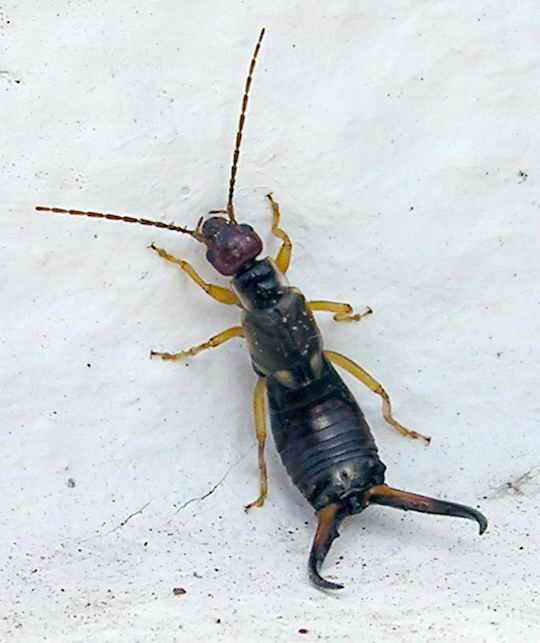
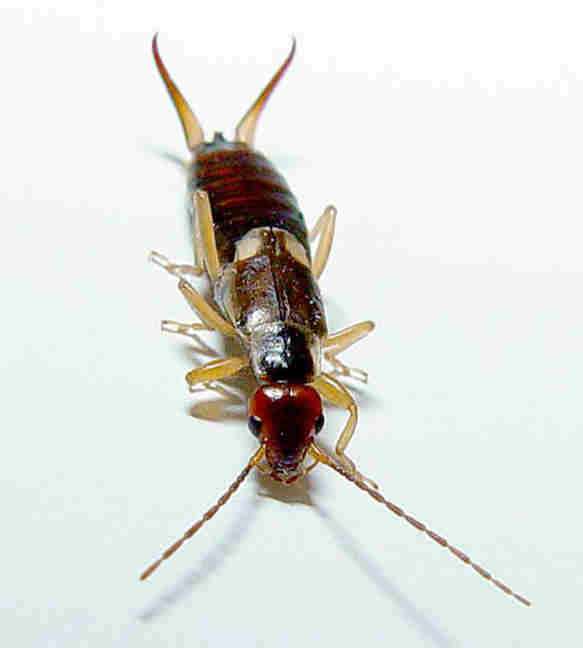
![Lesser earwig Labia minor Photo: By Whitney Cranshaw, Colorado State University, Bugwood.org - [1]; cropped, CC BY 3.0 us, https://commons.wikimedia.org/w/index.php?curid=8042297](images/Lesser_earwig.jpg)
Life cycle
The common earwig mates in the autumn and females make cavities in the soil or in rotten wood where they lay batches of 30-50 creamy white eggs. The female remains with her eggs throughout the winter, keeping them clean of fungal growth and reassembling the egg clutch if it becomes dispersed. The eggs hatch in early spring and the female continues to protect her brood until they have gone through their first moult. Earwig nymphs look like smaller versions of the adult insect and gradually increase in size as they go through four moults. Earwigs that have just moulted are white but soon develop the normal yellow and tawny brown colour. Sometimes an overwintered female earwig will produce a second brood of eggs in May.
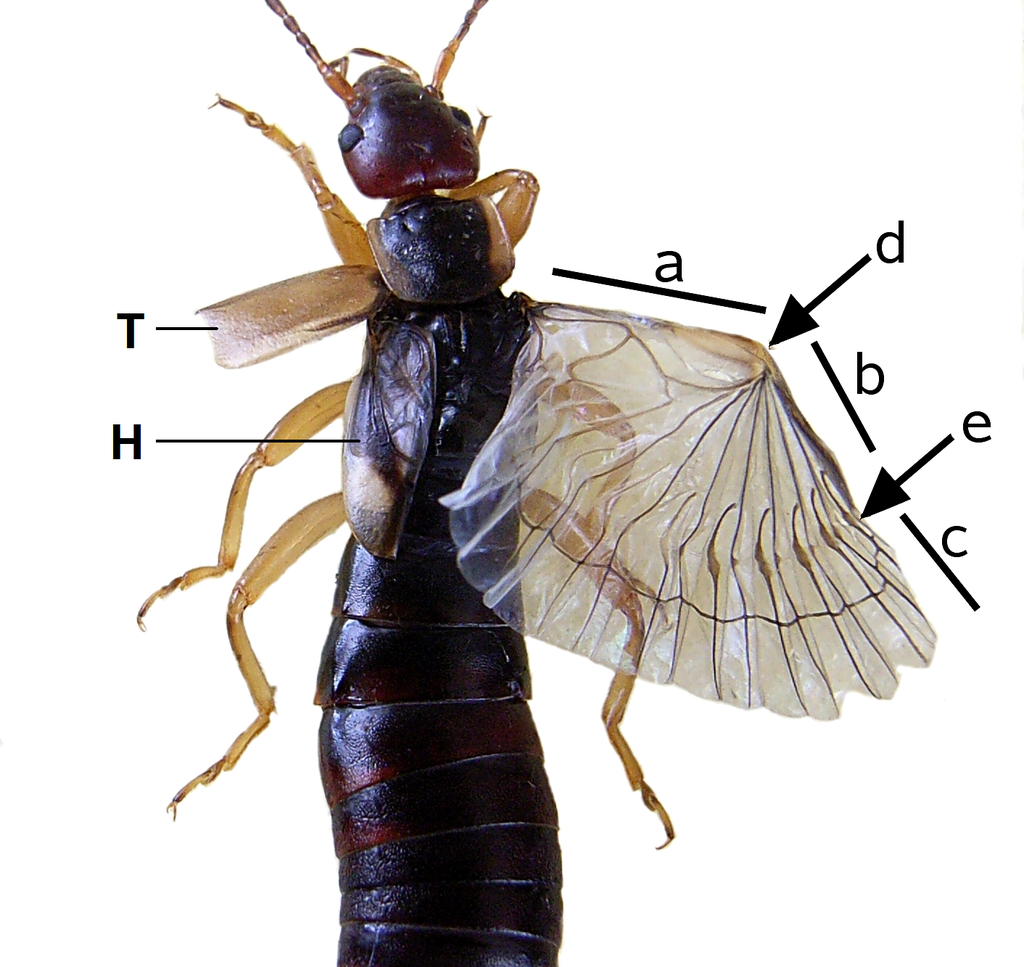
Earwigs fold their wings in an impressive and unique way. This image shows on the left the small protective forewing (T) and the folded hindwing (H).
On the right, the hindwing is partly expanded. There are two hinge points (d) and (e). The outer-most section of wing (c) can fold forwards like a fan, and then lies against the middle section (b). This in turn then folds inwards - again like a fan. The whole wing is then so reduced in size that it can be tucked onto the thorax, and covered by the forewing. This process is usually helped by manipulation by the legs.
This is a clever adaptation for an animal which doesn't often fly to have wings which are no inconvenience when folded, but which are functional if needed. The arrangement of beetle wings under hard protective elytra is similar, but they have only one wing fold axis.
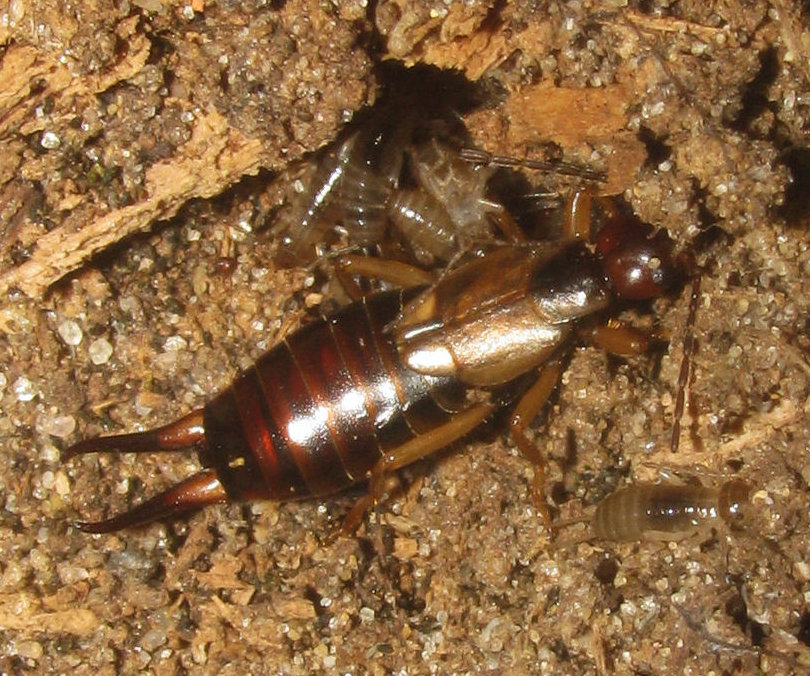
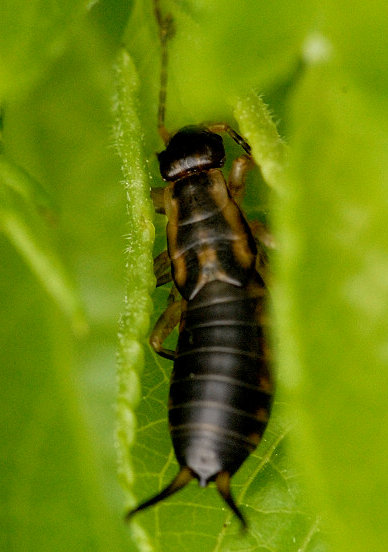
Left: Female common earwig with early instar nymphs Right: Late instar nymph
Role of earwigs in gardens
The common earwig can be a helpful predator of pests, such as aphids and will also feed on flowers and foliage of garden plants. Generally any damage is limited to a few plants so earwigs should be tolerated in gardens.
Helping earwigs in gardens
You can find lots of sites on the web offering ways to get rid of or control earwigs, but they really are not usually a problem, and generally beneficial, besides being fascinating insects. The do need crevices and enclosed spaces to hide during the day, and there is an interesting video here (in Dutch, but commentary not essential) showing how to create an earwig hide-away from a suspended flowerpot. The key point is the pot should rest against the tree trunk.
Other sources of information
Website
Website of the grasshoppers and allied insects recording scheme of Britain and Ireland
Identification guide to native earwigs (and cockroaches and stick insects)
RHS page on earwigs
Page text drafted by Andrew Halstead, reviewed by Andrew Salisbury, compiled by Steve Head
Earwigs
Earwigs are insects in the order Dermaptera an order allied to the orthopteroid insects which also includes the grasshoppers, crickets and cockroaches. They are characterised by having a pair of inwardly curved cerci like pincers on the rear end of their bodies. Some species can fly but the membranous hindwings are concealed under the truncated and thickened forewings, which resemble the forewings or elytra on staphylinid beetles. Earwigs are generally yellowish brown in colour and up to 15mm in length. They have long threadlike antennae. Earwigs are harmless, although males can give a slight pinch with their forceps. There seems no evidence that they crawl into human ears.
Species in Britain and Ireland
Seven species have been recorded in Britain and Ireland, three of which are occasional imports that do not seem to be established here. Of the four native species, only two are likely to be seen in gardens. By far the most abundant and widespread throughout Britain and Ireland is the common earwig, Forficula auricularia. Less common and much less frequently seen, especially in Scotland and Ireland, is the lesser earwig, Labia minor. The latter is associated with compost heaps.


![Lesser earwig Labia minor Photo: By Whitney Cranshaw, Colorado State University, Bugwood.org - [1]; cropped, CC BY 3.0 us, https://commons.wikimedia.org/w/index.php?curid=8042297](images/Lesser_earwig.jpg)
Left: Common earwig Forficula auricularia male with large heavy forceps. Centre: female common earwig. Right: Lesser earwig Labia minor
Biology
Earwigs are mainly active at night and during the day they hide in crevices. The common earwig is an omnivore feeding on a wide range of materials. They prey on small insects, such aphids, and will also eat insect eggs. They eat plant material as well and can damage ripening fruits and have a particular fondness for the flowers and soft young foliage of dahlias, chrysanthemums and clematis. In some years common earwigs are unusually abundant and at such times a much wider range of garden plants may be consumed. The lesser earwig feeds on invertebrates and decaying plant material.
The forceps on male earwigs are much more strongly curved than those of the female. Occasionally male common earwigs with exceptionally large forceps occur. The normal length is 2-3mm but up to 10mm is possible. Such specimens are called macrolabic forms. Earwigs have flexible abdomens and can use their forceps in self-defence and to seize prey insects. Common earwigs have fully developed wings but rarely fly; the lesser earwig does fly and is sometimes attracted to moth light traps.
This is a clever adaptation for an animal which doesn't often fly to have wings which are no inconvenience when folded, but which are functional if needed. The arrangement of beetle wings under hard protective elytra is similar, but they have only one wing fold axis.
Life cycle
The common earwig mates in the autumn and females make cavities in the soil or in rotten wood where they lay batches of 30-50 creamy white eggs. The female remains with her eggs throughout the winter, keeping them clean of fungal growth and reassembling the egg clutch if it becomes dispersed. The eggs hatch in early spring and the female continues to protect her brood until they have gone through their first moult. Earwig nymphs look like smaller versions of the adult insect and gradually increase in size as they go through four moults. Earwigs that have just moulted are white but soon develop the normal yellow and tawny brown colour. Sometimes an overwintered female earwig will produce a second brood of eggs in May.
Earwigs fold their wings in an impressive and unique way. This image shows on the left the small protective forewing (T) and the folded hindwing (H).
On the right, the hindwing is partly expanded. There are two hinge points (d) and (e). The outer-most section of wing (c) can fold forwards like a fan, and then lies against the middle section (b). This in turn then folds inwards - again like a fan. The whole wing is then so reduced in size that it can be tucked onto the thorax, and covered by the forewing. This process is usually helped by manipulation by the legs.

Left: Female common earwig with early instar nymphs Right: Late instar nymph -
Role of earwigs in gardens
The common earwig can be a helpful predator of pests, such as aphids and will also feed on flowers and foliage of garden plants. Generally any damage is limited to a few plants so earwigs should be tolerated in gardens.
Helping earwigs in gardens
You can find lots of sites on the web offering ways to get rid of or control earwigs, but they really are not usually a problem, and generally beneficial, besides being fascinating insects. The do need crevices and enclosed spaces to hide during the day, and there is an interesting video here (in Dutch, but commentary not essential) showing how to create an earwig hide-away from a suspended flowerpot. The key point is the pot should rest against the tree trunk
Other sources of information
Website
Website of the grasshoppers and allied insects recording scheme of Britain and Ireland
Page text drafted by Andrew Halstead, reviewed by Andrew Salisbury, compiled by Steve Head


- Home
- Garden Wildlife
- Insects
- Earwigs












